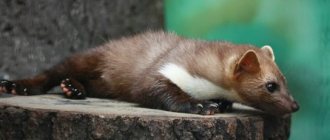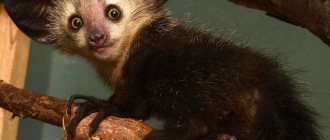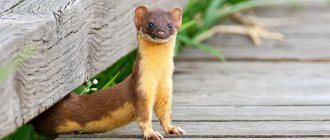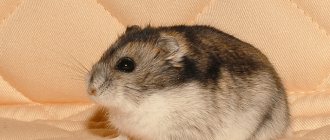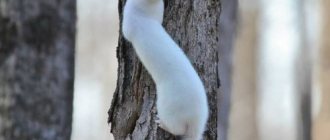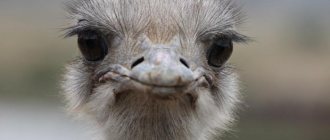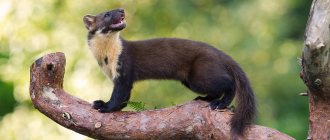Description and origin of the species
The first scientific description of the animal was given by the Swedish zoologist Carl Linnaeus in 1758. He named the animal Martes zibellina
, this name has survived to this day. The word "sable" is of Slavic origin, and in the early Middle Ages it spread throughout Western Europe thanks to the fur trade. Russian sable and Polish soból became German Zobel, Dutch sabel, Spanish cibelina, Portuguese zibelina, Italian zibellino. From the Italian variant came the Latin version of the name zibellina, which became the scientific name of the species.
Quality
How would the consumer like to see sable and mink fur? Of course, high quality, without any defects. However, this is completely impossible, because animals are caught in one of the two most effective ways - by shooting with a gun or using all kinds of self-catchers. Both options, of course, spoil the fur. Guns leave traces of bullet holes, damage hair with bullets and shot, and fur becomes stained with blood. In addition, no one is immune from ruptures from a hunting dog. Self-catchers also lead to some defects. For example, to the absence or damage of paws and fur.
Skins can also suffer if they are removed and processed incorrectly. Considering the considerable cost of this fur, hunters need to be very careful about the processing process. That is, in no case should you allow the formation of tears, incorrect cuts, drafts, etc.
What does sable look like?
The animal has a flexible, elongated body, a long neck, a sharp muzzle and relatively large rounded ears. Males are usually 38 to 56 cm long, with a 9-12 cm tail and weigh 880-1800 grams. Females are slightly smaller in size - the female’s body length is 35-51 cm, with a tail 7.2-11.5 cm. The sable is a very dexterous and strong animal for its size.
In size and appearance, the sable is very similar to the pine marten, but there are also differences between these species. The sable has a larger and more elongated head, a more pointed muzzle, larger ears and a shorter tail. The fur of the sable is softer and silkier than that of the American marten.
In winter, the animal's fur is longer and thicker than in summer. The color of the animal varies from light to dark brown depending on its habitat. The fur on the back and paws is usually darker, the fur on the belly is lighter. The Japanese sable has black limbs. Some individuals have a light spot on the throat, gray, white and yellowish.
Typical sable colors:
- head - dark, almost black fur without light spots;
- fur - light, fawn or pale yellow color;
- collar - brown fur with a dark back, sides and belly of a lighter shade and a large light spot on the throat.
Barguzin (animal): description
Barguzin is a subspecies of sable, distinguished by its relatively small size and darker fur color. According to these characteristics, it is second only to Vitim sables. Its habitats: the coast of Lake Baikal (eastern); Barguzinsky ridge from the tributaries of the river. Barguzin (right) to the watershed with the river. Hangar (upper). A very modest and quiet animal, the Barguzin. Its dimensions are very small.
The body together with the head has a length of about 395-420 mm in males and 360-410 mm in females. The tail length of the male is from 122 to 155 mm, and that of the female is from 120 to 145 mm. The sable lives in the Baikal forests.
What does a sable eat?
Despite belonging to the order of Predators, the sable is omnivorous. Its diet varies depending on the season and habitat of the animal. The basis of the diet is:
- hares
- pikas
- squirrels and chipmunks
- birds - hazel grouse and wood grouse
- mouse-like rodents, mainly red and red-gray voles
On occasion, the sable hunts other predators; ferrets, weasels and stoats can become its prey. Occasionally he hunts musk deer, a small deer from the Musk deer family. Periodically, the sable eats snails, which it rolls on the ground to get rid of its shell, and is able to catch fish with its front paws. The predator often follows larger predators - wolves, tigers and bears - to feast on the remains of their prey.
In summer, the animal supplements its diet with plant foods, berries and nuts. Prefers pine nuts, blueberries, rowan berries, lingonberries, blueberries, bird cherries, lemongrass, Amur grapes, rose hips and currants.
Stage number one
Where does it all begin? Before obtaining products from sable fur, it is, of course, necessary to first remove the skin. To remove it with a tube, you need to make a cut from the middle toe of one hind paw along its inner side to the toe of the other. The tail is cut along the underside from root to tip. The skin is removed starting from the hind legs. The carcass is hung in different directions, the edges are pulled down. As a result, the skin is removed from the front paws and head. Finally, the lips and nasal cartilage are trimmed.
When skinning with a stocking, the first cuts are made on the head. The carcass is hung from it. The skin shrinks completely. No cuts are made on the paws. At the very end, the tail is cut along the lower surface.
Where does the sable live?
As a habitat, the predator prefers dense forests of pine, larch, spruce, cedar or birch. The sable lives primarily in the Russian taiga, in the forests east of the Ural Mountains throughout Siberia, the Far East and Sakhalin. The predator can also be found in northern Mongolia near the Russian border, in the Altai mountains and in the forests around Lake Khubsugul.
In China, the animal lives in the Xinjiang Uyghur Autonomous Region in the northwest of the country, and in the Greater and Lesser Khingan mountain ranges in northeast China. The animal can be found in eastern Kazakhstan, Korea and on the island of Hokkaido in Japan. Previously, the predator was also found in the European part of Russia, Poland and Scandinavia.
Character and lifestyle
Sables are active primarily at dusk, but become more active during the day during the mating season. Each predator has its own territory, ranging from 4 to 40 square kilometers, which the animals actively protect from their relatives. The animals prefer a sedentary lifestyle, but are able to walk from 6 to 12 km a day in search of food.
Predators live in tree hollows and burrows dug between tree roots. Dens are usually well hidden, lined with grass, moss and leaves inside. The animal usually has several temporary shelters, since in winter sables are forced to travel long distances in search of food.
The animal has excellent hearing and sense of smell, which it relies on when hunting. The predator's vision is poor. It moves in 30-70 cm long jumps, climbs trees well and swims well. The sable purrs with pleasure and chirps, and yelps or growls when it is angry.
Wild animal behavior
The animal can hunt at any time of the day. He loves to move on the ground. He rarely climbs trees, and only jumps into water as a last resort. He can run over 3 km in a day . The mileage length increases significantly in winter. In search of food, he has to lead a nomadic life. In the summer, he reduces his runs, because there is a chance of stumbling upon a killed large animal.
The animal's tracks in the snow are clearly visible in the photo.
The sable sets aside a section of territory for itself where it hunts for a long period of time.
If there is enough food there, the animal will build a hole for itself and tromp paths from the home to the hunting grounds . He builds temporary burrows near large killed animals, narrowing the circle of his movement from the burrow to the feeding site.
In winter, a wild animal knows how to move under a layer of snow. It may not come to the surface for a week, building tunnels in the thickness of the snow cover.
The animal can make nests for itself in hollows and under the roots of large trees, in rocky places.
Reproduction and young
The mating season for sables usually lasts from June to August, although the timing may vary depending on the animal’s habitat. During courtship, the animals meow, make guttural sounds and grumble loudly. Males actively leave urine marks and fight fiercely for the female. Mating can last up to 8 hours.
The fertilized egg does not enter the uterus immediately, but with a delay of 8 months. Therefore, pregnancy in animals lasts 245-298 days, while the actual maturation of the fetus takes only 25-30 days. Females give birth in dens built in a hollow tree or between stones lined with moss, leaves and dry grass. From 1 to 7 puppies are born in one litter, although litters of 2-3 cubs are most common. Males help females by defending territory and providing food.
Cubs are born blind and almost bald, with a little sparse fluff. They weigh 25-35 grams at birth and are about 10-12 cm long. The eyes open from 30 to 36 days, and soon after this the puppies begin to emerge from the den. From 7 weeks, the cubs gradually switch from breast milk to food chewed by their mother. Juveniles reach sexual maturity at approximately 2 years of age.
Sables can interbreed with pine martens. In the wild, this often occurs in the region of the Ural Mountains, where the ranges of the two species intersect. The result is a hybrid - kidus, an animal slightly smaller in size than a sable, with coarser fur, and a long fluffy tail. Kidus are usually sterile, although there is one recorded case of a female Kidus successfully siring with a male pine marten.
Editing features
The next steps are fleshing and degreasing the resulting skin. Do not forget that in order to obtain beautiful, high-quality products, sable must be processed very carefully. The types of fur influence the chosen editing method. The most suitable rules should be selected for each ridge. The following constructions are most often used.
Elkov straighteners are intended for straightening skins removed with a tube. They give them a rectangular shape.
No less popular is the use of Ignatov’s design. These rules give the skin a long shape. They are, in turn, divided into three types (65, 60 and 55 centimeters in length and, respectively, 10.9, 10 and 9.2 centimeters in width). The width of the planks is 2.5 centimeters, the thickness is 1 centimeter.
To straighten skins removed with stockings, oval-shaped rules are used. Thanks to them, it is possible to achieve an oval shape. The design is also manufactured in three rooms. Length – 48, 40 and 32 centimeters, width – 12, 10 and 8 centimeters.
Types of sable
Due to its wide habitat and different colors, scientists still have not reached a consensus on the number of subspecies of the animal. The 2005 Mammal Guide "Mammal Species of the World" recognized 17 subspecies of the carnivore. According to more recent estimates, from 7 to 30 subspecies are distinguished. The most famous subspecies:
- Tobolsk sable ( M. z. zibellina
) - Barguzin sable ( M. z. princeps
) - a particularly valuable subspecies with silky black fur - Sakhalin sable ( M. z. sahalinensis
) - Yenisei sable ( M. z. yenisejensis
) - Sayan sable ( M. z. sajanensis
) - Yakut sable ( M. z. jakutensis
) - Kamchatka sable ( M. z. kamtshadalica
) - Kuznetsk sable ( M. z. tomensis
) - Altai sable ( M. z. averini
) - Vitim sable ( M. z. vitimensis
) - Ussuri sable ( M. z. arsenjevi
) - Chicoa sable ( M. z. obscura
) - Kuril sable ( M. z. brachyura
) - is endangered. - Japanese sable (M. z. brachyurus
).
Natural enemies
In the wild, sables are hunted by larger predators - wolves, bears, lynxes, tigers, wolverines and foxes. Cubs are often carried away by owls and eagles.
Population and protection of the species
The sable is listed as a species of least concern on the IUCN Red List. The population in Russia, according to 2017 estimates, was more than 1.4 million individuals.
Sable fur is very expensive, so the main threat to the animal comes from hunters and poachers. In recent years, 500-600 thousand skins per year are sold in the world, the lion's share of which is Russian sable. In Russia, the limit on the production of animals is set by the Ministry of Natural Resources. The sales volumes of skins at the St. Petersburg fur auction consistently exceed the permitted production quotas by 1.5-2 times, since some of the animals are bred on farms.
Breeding sable in captivity
Breeding sable in captivity is very difficult. This animal is very mobile and requires a large territory for its life.
The cage must be equipped with a reliable bolt, and the windows should be covered with iron mesh. This animal is very savvy and will open the lock without difficulty. To create comfortable living conditions, you can put plastic toys in the cage; the animal loves to play . When breeding sable in enclosures, the female will show aggression towards the male after mating; the animals are immediately seated.

